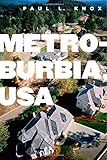Metroburbia, USA / Paul L Knox.
Material type: TextPublisher: New Brunswick, NJ : Rutgers University Press, [2008]Copyright date: ©2008Description: 1 online resource (248 p.) : 18Content type:
TextPublisher: New Brunswick, NJ : Rutgers University Press, [2008]Copyright date: ©2008Description: 1 online resource (248 p.) : 18Content type: - 9780813543567
- 9780813545158
- 307.760973 22
- online - DeGruyter
- Issued also in print.
| Item type | Current library | Call number | URL | Status | Notes | Barcode | |
|---|---|---|---|---|---|---|---|
 eBook
eBook
|
Biblioteca "Angelicum" Pont. Univ. S.Tommaso d'Aquino Nuvola online | online - DeGruyter (Browse shelf(Opens below)) | Online access | Not for loan (Accesso limitato) | Accesso per gli utenti autorizzati / Access for authorized users | (dgr)9780813545158 |
Frontmatter -- CONTENTS -- FIGURES AND TABLES -- PREFACE -- CHAPTER 1. Introduction -- CHAPTER 2. Prelude: THE SERIAL ENCHANTMENT OF SUBURBIA -- CHAPTER 3. Metroburbia and the Anatomy of the New Metropolis -- CHAPTER 4. Developers' Utopias -- CHAPTER 5. Comfortably: Numb DEGENERATE UTOPIAS AND THEIR EVANGELISTIC CONSULTANTS -- CHAPTER 6. The Politics of Privatism -- CHAPTER 7. Material Culture and Society in Metroburbia -- CHAPTER 8. Vulgaria: MORAL LANDSCAPES AT THE LEADING EDGES OF THE NEW METROPOLIS -- NOTES -- BIBLIOGRAPHY -- INDEX
restricted access online access with authorization star
http://purl.org/coar/access_right/c_16ec
Decades of economic prosperity in the United States have redefined the American dream. Paul Knox explores how extreme versions of this dream have changed the American landscape. Increased wealth has led America's metropolitan areas to develop into vast sprawling regions of "metroburbia"ùfragmented mixtures of employment and residential settings, combining urban and suburban characteristics. Upper-middle-class Americans are moving into larger homes in greater numbers, which leads Knox to explore the relationship between built form and material culture in contemporary society. He covers changes in home design, real estate, the work of developers, and the changing wishes of consumers. Knox shows that contemporary suburban landscapes are a product of consumer demand, combined with the logic of real estate development, mediated by design and policy professionals and institutions of governance. Suburban landscapes not only echo the fortunes of successive generations of inhabitants, Knox argues, they also reflect the country's changing core values. Knox addresses key areas of concern and importance to today's urban planners and suburban residents including McMansions, traffic disasters, house design, homeowner's associations, exclusionary politics, and big box stores. Through the inclusion of examples and photos, Metroburbia, USA creates an accessible portrait of today's suburbs supported by data, anecdotes, and social theory. It is a broad interpretation of the American metropolitan form that looks carefully at the different influences that contribute to where and how we live today.
Issued also in print.
Mode of access: Internet via World Wide Web.
In English.
Description based on online resource; title from PDF title page (publisher's Web site, viewed 30. Aug 2021)


